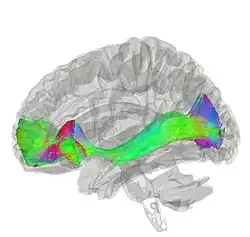Occipitofrontal fasciculus
| Occipitofrontal fasciculus | |
|---|---|
 Tractography showing occipitofrontal fasciculus | |
| Details | |
| Identifiers | |
| Latin | fasciculus occipitofrontalis inferior |
| NeuroNames | 1442 |
| TA98 | A14.1.09.561 A14.1.09.562 |
| TA2 | 5601, 5602 |
| Anatomical terms of neuroanatomy | |
The occipitofrontal fasciculus, also known as the fronto-occipital fasciculus, passes backward from the frontal lobe, along the lateral border of the caudate nucleus, and on the medial aspect of the corona radiata; its fibers radiate in a fan-like manner and pass into the occipital and temporal lobes lateral to the posterior and inferior cornua.
Some sources distinguish between an inferior fronto-occipital fasciculus (IFOF) and a superior fronto-occipital fasciculus (SFOF), however the latter is no longer believed to exist in the human brain.[1]
References
![]() This article incorporates text in the public domain from page 844 of the 20th edition of Gray's Anatomy (1918)
This article incorporates text in the public domain from page 844 of the 20th edition of Gray's Anatomy (1918)
- ↑ Meola, Antonio; Comert, Ayhan; Yeh, Fang-Cheng; Stefaneanu, Lucia; Fernandez-Miranda, Juan C. (December 2015). "The controversial existence of the human superior fronto-occipital fasciculus: Connectome-based tractographic study with microdissection validation". Human Brain Mapping. 36 (12): 4964–4971. doi:10.1002/hbm.22990. ISSN 1065-9471. PMC 4715628. PMID 26435158.
External links
- Türe U, Yaşargil MG, Pait TG (June 1997). "Is there a superior occipitofrontal fasciculus? A microsurgical anatomic study". Neurosurgery. 40 (6): 1226–32. doi:10.1097/00006123-199706000-00022. PMID 9179896.
- Kier EL, Staib LH, Davis LM, Bronen RA (May 2004). "MR imaging of the temporal stem: anatomic dissection tractography of the uncinate fasciculus, inferior occipitofrontal fasciculus, and Meyer's loop of the optic radiation". AJNR Am J Neuroradiol. 25 (5): 677–91. PMID 15140705.
This article is issued from Offline. The text is licensed under Creative Commons - Attribution - Sharealike. Additional terms may apply for the media files.